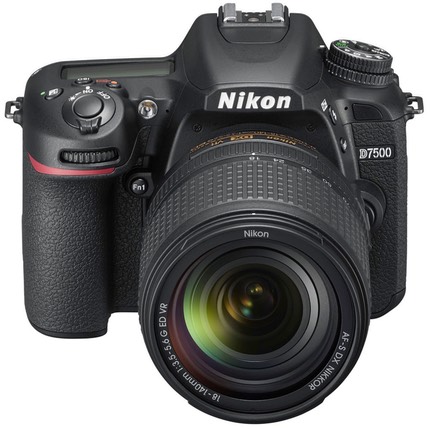
What is It?
The D7500 is the eighth in a venerable lineup of Nikon DSLRs that started with the D70.
D70 -> D70s -> D80 -> D90 -> D7000 -> D7100 -> D7200 -> D7500
These cameras have all sat squarely at the top of the Nikon consumer DX lineup, and priced just above the US$1000 mark at entry, then right about US$1000 as the generation ages.
The D70 itself was a brilliant camera when it came out, sitting right in that crack between true consumer product and true pro product that the photo enthusiasts tend to occupy. The "price perfect point," if you will. The D70 triggered a massive switch from film to digital all on its own within the Nikon crowd as N80's and even F100's got retired.
The followup D80, on the other hand, was a dud with a sensor that didn't live up to expectations. The D90 was another big winner, and the first DSLR from anyone with video capabilities.
The D7000 had focus issues for many, but the D7100 and D7200 fixed that and added a great deal of sophistication and performance to the basic price perfect point concept. Now, thirteen years after the D70 first established the line, we have the latest iteration in the D7500.
Right up front we need to discuss the Internet Elephant in the room: feature removals. Yes, Nikon took out a few things from the D7500 that were in the D7200: (1) the second card slot; (2) the AI index tab for old manual focus lenses; and (3) any provision for adding a vertical grip. Some think that going down to 20mp from 24mp in the preceding model is also a "removal."
But it's not as if the D7500 went backwards. I'll say this several times in this review: the D7500 is clearly a D5-generation camera. By that I mean we get things like an EXPEED5 processor and image sensor that can do 4K video and expand the buffer, a new shutter that provides 25% faster frame rates (8 fps max), a tilting touchscreen LCD (below), a better and faster metering sensor, a new internal frame design that's more robust (coupled with some better weather sealing), electronic first curtain shutter, and more.
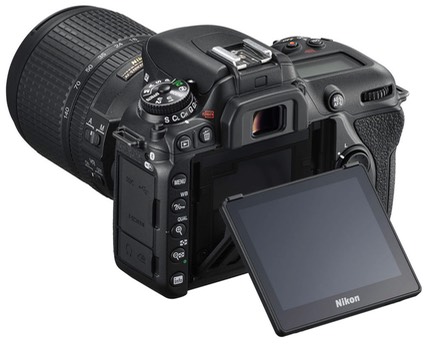
Some subtle things show up, too: you can rename the storage folder (D7500 portion of the folder name, not just the number). Flash control moves out of the Custom Setting backcountry and onto first page of the Photo Shooting menu where it belongs. The video options expand, as do the bit rates at which high quality video is recorded. And in the realm of good news/bad news, we get SnapBridge compatibility, including both the Bluetooth and Wi-Fi capabilities.
Funny thing is, I tried compiling a full list of differences between the D7200 and D7500, and I was surprised at how many things I found that were different. Too many for a quick table here. I think that the Internet consensus seems to be "not much different than the D7200, thus not interesting, especially considering those removals." I'm going to beg to differ in this review.
Why Nikon's marketing department can't get in front of this, I have no idea. But I'll say it up front before I even get to the performance section of this review: if you give me a choice of a D7200 or D7500, I'll pick the D7500 every time. The sum of the parts actually make for a better camera.
So let's examine some of those parts.
Inside we get the D500's image sensor. That's 20mp instead of the 24mp that the previous D7100 and D7200 featured, but the actual difference in resolution is minimal. What's different is that the D500 sensor is faster at offloading data, allows 4K video (with an additional 1.5x crop, unfortunately), and has attributes that keep it right at the top of what's available in APS-C sized sensor capability.
I actually like that Nikon is re-using the D500 sensor rather than trying to add to the D7200 sensor. And the D500/D7500 sensor is really 20.7mp, so you're not losing a lot of resolution. Are you gaining something? Yes, though it will be difficult to describe that, as we're talking about very small differences. The dual-gain aspect of the new sensor means that the D7500 starts ever so slightly behind the D7200 at base ISO, but eventually ends up ever so slightly ahead at very high ISO values, for instance.
ISO starts at 100 and goes to 51200 on the D7500, with 50 and up to 1640000 possible via Lo and Hi settings. The sensor also can provide 3-axis Electronic VR for 1080P video.
In the end, it's the speed of the new sensor that makes the most dramatic difference. The new shutter in the D7500 coupled with the sensor give us 8 fps without any need of battery boost, cropping, or other gimmick. 8 fps is that point at which a camera starts to become very useful for sports and wildlife shooting of continuous action. Below that, and there's just too high a chance you "miss the moment." At 8 fps the likelihood that you get wing position or ball position or player position nailed in a continuous sequence starts to become high. Coupled with a huge buffer—typically 50 raw, 100 JPEG, but I'll outline that more in the performance section—the D7500 can shoot for very long sequences at high frame rates.
The D7500 also has a 1.3x crop option. The one thing I wish we had gotten is something like 10 fps at that crop level. Instead, we're still at 8 fps. Still, having that crop available sometimes saves me space and time.
The focus system at first looks to be the same as the D7200, but it isn't exactly the same. Yes, it's still 51 points, but it's the D750 type focus sensor now, which gives us slightly better low light performance. That isn't the real change, though. The real change is that EXPEED5 coupled with the new 180k pixel metering sensor actually starts to make Auto and 3D Tracking usable, as it is in the D500, D850, and D5. We also get the automatic AF Fine Tune capability.
I've mentioned the rear LCD. Another of those things that people think was Nikon taking away something is that the D7500 is 922k dot while the D7200 is 1.2m dot, both on a 3.2" LCD.
Nope. Most people don't understand what "dots" actually mean, and you need more than the absolute number, you need to know how they're oriented. The D7200 uses a four-color striping, the D7500 a three-color. Both actually produce the equivalent of a 640x480 pixel display (VGA equivalent). But there's more to it than just even that. Nikon's using other technologies in the display now, and the D7500's display looks crisper, sharper, and with better contrast than the D7200's. It's a small thing, but if I'm examining an image zoomed in, I much prefer to do so on the D7500 than the D7200: I can identify what the pixels are actually recording easier.
Some things haven't changed between the D7200 and the D7500. The viewfinder is the same, for example (100%, 18.5mm eyepoint), though there's now a sensor to turn off the rear LCD when your eye is at the viewfinder (yep, you're going to keep hearing about these subtle differences that Nikon never really trumpeted).
The left side connections are the same (mic, headphone, HDMI, USB, accessory), but now under two less-floppy doors rather than the three articulated and very floppy doors of the D7200.
Somehow in all this small level changing that Nikon did, the D7500 lost weight, too. It comes in at 720g (25.4 ounces) instead of the D7200's 765g (27 ounces).
The D7500 is made in Thailand and retails for US$1250.
Source of the review unit: purchased
Nikon's Web page for the D7500
Thom's Book on the D7500
How's it Handle?
Yes, some cheese moved. Basically the D7500 takes on the D5 generation control operations. The ISO button moves to behind the shutter release, and we've got touch controls on the rear LCD.
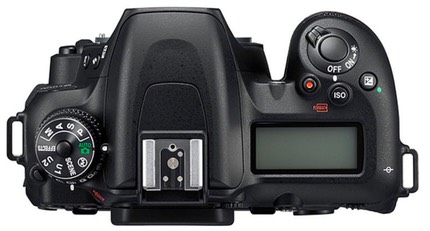
That doesn't seem like a lot, but it makes an already good camera (D7200) better (D7500).
Get used to those touch controls. As with the D850, they're pretty deeply implemented. Most things in the menus can be done faster via touch than with the Direction pad. That's especially true when you've got the camera low on the ground and want to reset something (the rear LCD tilts).
There are "removals" that don't get talked about on the D7500. For example, the top LCD is one of the most simple we've seen recently on a Nikon DSLR. Plenty of icons and details have been removed to make a slender, simpler readout. This turns out to have been a reasonable decision, too. There's little I miss in the top LCD information: it sticks to the basics. If you need more, the Info button brings that right up on the rear LCD.
A lot has been made by others of the new body sculpting, particularly the deeper hand grip that the narrower main body design provides. I'm not particularly impressed by that. Yes, it's a little easier to get a tight strangle hold on the camera with your right hand now, but that has also made it slightly less comfortable to get to the Fn1 and Fn2 buttons. There's nothing dramatic here, just a small change that some will like, some won't.
Nikon ended up with some menu simplification, too. Without the second card slot we don't get things that come with that (e.g. Role played by Slot 2) or the tricky controls to get to the other card for viewing. Without AI indexing, the Non-CPU Lens menu item goes away.
It might not seem like much, but the half dozen things that went away or collapsed into a single option in the menu system just make the menus a little faster to navigate. Now if only SnapBridge weren't a half dozen menu entries and a few other areas were collapsed into a simpler structure we'd have a very tight menu system indeed.
Other small touches abound, and are only going to be noticed by D7200 and previous users of this line of body. One that is interesting has to do with Depth of Preview. There's no Depth of Preview button (you can't assign the function buttons to DOF Preview). But there is depth of field preview. It's always present in Live View. This was a change I almost didn't catch at first, but did when I was working my way through writing my book: while the D7500 at first seems to be doing what the other Nikon consumer DSLRs do in Live View, which is not respect aperture, it actually is respecting aperture.
At the camera defaults, the exposure you think you see is overridden by a faux automatic ISO system in Live View, but the actual aperture being used does get changed! Thus, in low light where manual exposure of 1/250 and f/16 might not be enough to normally see what's going on, the hidden and temporary ISO change makes for a bit of a grainy look, but you are looking at f/16. Change the aperture to f/1.4 where it generates a proper exposure and the view becomes less grainy and yes, you're looking at a fully open aperture. So, yes, DOF changes are easy enough to see: just use Live View.
Of course, maybe that's not what you want. Maybe you want to see your exposure as well as DOF. Okay, another small change: press the i button and set Exposure Preview to On. Now you get no fake ISO boost and see your image as it will be captured, complete with an exposure bar on the right side (and now you can also pull up a useful histogram using the Info button).
After thinking about this one for awhile, I like this far better than what the D7200 did. In a very subtle and almost hidden way, the D7500 is much more sophisticated than the D7200, which basically ignores aperture changes while in Live View. While this is just one example, there are plenty of others that are similar: someone spent some time deeply thinking about what a more sophisticated user would want the camera to do. I'm not at all surprised that Nikon has no idea how to market changes like that.
The absolutely what-was-Nikon-thinking handling decision on the D7500 revolves around the missing AI-index tab and the related fact that you can't set the camera to respect aperture rings. Why? Because of video, that's why! Look, for still shooting I don't miss the Non-CPU lens thing at all. But if I want to record a video? Oops. I actually want to use a lens with an aperture ring on it when shooting video. That way I can manually control exposure with a declicked lens. Instead, Nikon wants me to use the Fn1 and Fn2 buttons with Power Aperture Open and Power Aperture Close (and by the way, why aren't those the default button assignments, Nikon? Much more useful than Index Marking).
The shame is that the D7500 is a remarkably good video camera, but you can only use Nikon autofocus lenses on it and then use nonsensical controls for exposure changes during recording. If there's any decision I've seen out of Nikon in the recent past that shows me that they just don't get video, it's this one. Great video camera, but for high practitioners it is hobbled by a missing and simple two-bit part.
Still, overall I'm happy with all (but one) of the handling changes. I feel a little more in charge of the D7500 for shooting stills than I did with the D7200, and that's because the right things have been emphasized and de-emphasized on the new model.
Okay Nikon, I see where you moved my cheese, and I approve. As for the bean counter that insisted that the AI-indexing arm and Non-CPU Lens be removed: may you be forced to eat cheese in your soon-to-be office-with-a-window.
How's it Perform?
Battery: Don't get hung upon the reported CIPA number (950 frames/charge). Remember, CIPA requires taking every other image using flash, and that means that the camera has to recharge the flash capacitor every other shot, which is a pretty substantive drain on the battery. The number looks worse than the D500 and D850 because of this (they don't have an internal flash).
In real shooting without the internal flash, I've been getting double the quoted battery life, even with a great deal of touch screen work and other options enabled. If you're using the D7500 for something like burst shooting of wildlife or sports, that number will go even higher.
More so than a lot of the Nikon bodies, battery performance on the D7500 is going to vary a lot on how you use it. SnapBridge, internal flash, touch-screen Live View, and a host of other items can draw down what is typically really excellent battery performance. Just general shooting without those features turned on? Really, really good. The envy of mirrorless shooters, even those using cameras with bigger batteries these days (I'm looking at you Sony).
Buffer: I wasn't really expecting this, but the D7500 buffer performance is almost exactly double that of the already-quite-good D7200 with the same card and settings. To the point where you can actually shoot raw (12-bit Compressed) at 8 fps and shoot for over twelve seconds if you need to. Ditto any JPEG setting.
I was a bit worried by the fact that Nikon didn't make the D7500 UHS-II compatible. As it turns out, UHS-I 95Mbps is fast enough to give you a very deep and useful buffer. I put that mostly on the fast sensor offload (same as D500) and the EXPEED5 chip, basically. Nikon knew they would gain buffer performance with those changes so didn't roll any new card technology into this iteration of the D7xxx series.
I shot birds in flight for two weeks in the Galapagos with the D7500. I don't think I ever hiccuped the buffer (though I'm not a shutter release masher like some; the longest sequence I see in my files is 38 NEF images).
Focus: Likewise, the focus system improved from the D7200 to the D7500. It's subtle, but real. Nikon made some claims about "faster in low light" with the D7500, and that seems correct, but side-by-side with the same lens on each model, my D7500 tracks better than my D7200, and seems to acquire focus a bit more reliably.
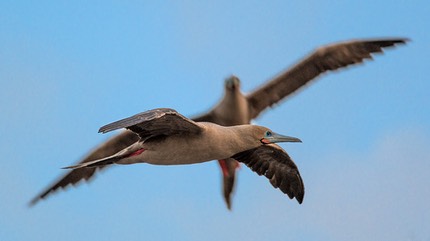
Yeah, try that with many cameras and see what you get. I was following the front bird panning left to right when I got the additional bird dead behind what I was shooting. In many tracking systems, background detail causes immediate confusion. The D7500 didn't budge from where I had put it.
These aren't things that are easily quantified. I actually wasn't aware of any focus performance change until I pulled out my D7200 and shot it simultaneously with the D7500. Even then, it took a few tests to verify my conclusion: Nikon managed to tweak a bit more out of the venerable 51-point focus system.
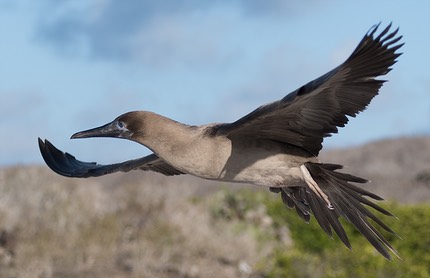
This bird is flying fast and furious right past me. I could barely control my body while panning. The camera? Still focused where I put it (on the side of the bird; here the bird turned it's head unfortunately, so the front of the beak is a little less sharp than the neck). How close was I? Well, consider the next image:
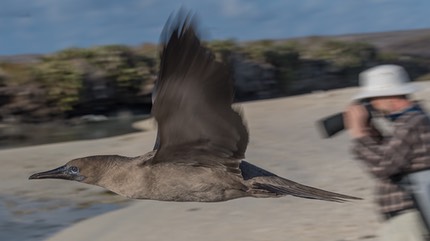
If you notice anything different: I dropped my shutter speed to 1/160 here as I was trying to figure out what shutter speed I needed to keep a sharp bird with blur in the background. Camera's still focused where I put it. And that other photographer? About 10 feet from me.
Part of the focus performance improvement is due to the metering sensor. Like the other D5 generation cameras (D5, D500, D850, and D7500 to date), the D7500 got a big boost in the density of the metering sensor (180k pixels). This allows it to detect faces in Auto and 3D Tracking modes and seems to help the camera follow subjects better when continuously shooting, as well.
Don't expect huge improvements over the D7200, but I can see a clear change over the D7200 even if I can't exactly measure it. Nikon's gotten a lot of grief over things that they "took away" from the D7200 in creating the D7500, but not a lot of people are pointing out the things they made better. As you might be starting to see from this review, many of those changes are subtle, but real. So let me say this: if all else were equal, would I pick a D7200 or D7500 for focus performance? No doubt in my mind the D7500, especially if you use the more sophisticated settings like 3D Tracking, where the difference shows up a little more clearly.
Image quality: Let me start by noting that the D7200 was the best APS-C sensor camera of its time, and by a clear margin. That Toshiba 24mp sensor produced wide dynamic range at base ISO and cleanly degraded as you bumped up the ISO. The underlying characteristics of that sensor were quite good: it had very little fixed pattern noise, low read noise, generally good hot pixel properties under stress, and since it had no AA filter over it, generated a great level of detail for a DX camera.
The D7500 pretty much matches that.
At base ISO the D7500 is perhaps a third of a stop worse than the D7200. Above ISO 400, that flops to the D7500's advantage, with a fairly clear third of a stop advantage at ISO 6400 and above. And again, the D7500's sensor seems free from fixed pattern noise and its hot pixel properties are also excellent. Nikon's noise handling for JPEGs has improved, too. I was a little surprised that I now find ISO 12800 usable for JPEGs with High ISO NR set right with no underexposure. (Note I wrote "usable," not "desirable.")
Does losing a bit more than 3mp change anything? Not really. You lose about 7% in terms of resolution. As I've written before, studies tend to say that you really need at least 15% change in resolution before most people can even detect a difference.
To me, the "character" of the pixels starts to be more important when resolution differences are minimal. Both the D7200 and D7500 fare really well there. The D7500 appears to retain color information a little better at high ISO than the D7200. The EXPEED5 processor in the D7500 also produces better looking JPEGs at high ISO values than the D7200.
But we're picking at nits all across the board here. The D7200 and D7500 represent two of the best APS-C cameras ever. You really want to spend time looking at what lenses you're using with cameras this good.
Final Words
Nikon made some interesting choices with the D7500. There's little doubt that it's a D5-generation camera. The tilting LCD, the touch controls, the boost in metering pixel count, and plenty of small touches throughout the menus and even in the performance sections of the camera (e.g. doubling of the buffer) all point to plenty of current and excellent Nikon engineering.
Heck, while they look very similar, the D7500 frame and body is all new compared to the D7200, making for a slightly lighter body that seems a bit more rigid and has better weather sealing, particularly at the bottom (no electronic contacts courtesy the missing grip).
Nikon's marketing doesn't do any of that justice. Somehow the basic conversation got bent by Nikon users to reflect the things that looked like steps backward: the removal of a card slot, the removal of the AI index tab, the lack of a vertical grip option, and the lower CIPA battery number. Couple that with the complexity of SnapBridge in the D7500 compared to the basic simplicity of WMU Wi-Fi in the D7200, and the Internet heated up with plenty of D7500 negativity almost immediately.
Let me step in with a more rational view based upon actual use: the D7500 is a better camera than the D7200. The focus is a little better, JPEG rendering is better, the metering more nuanced, the touch/tilt LCD and changes to Live View makes it faster and easier to do so many things, plus the bigger buffer despite the 25% higher frame rate all conspire to make the D7500 seem more professional than consumer, and better than the D7200 before it.
Is it as good a camera as it could have been with an AI index tab, a second card slot, and a vertical grip option? Nope. But don't dismiss this camera. As the latest in a long line that started with the D70, the D7500 more than holds its own as a solid enthusiast's camera with excellent features, characteristics, and performance.
Indeed, while using the D7500 extensively since it came out, I can't think of a time that I've really noticed the things that Nikon took out (other than for video). Okay, that's not quite accurate: recently I got a Laowa 15mm f/4 and Irix 15mm f/2.4 for review. The Laowa doesn't have electrical contacts, so can't be used on the D7500. The Irix does and works just fine. So, yes, every now and then I discover those Nikon removals working against me. But for the most part, I forget about them when I'm shooting stills.
Sometimes I have to stop and remember how spoiled I am. The D850 is a tremendous camera. But it's more than most people need. The D7500 is a tremendous camera, and it's priced and set right at the heart of much of the Nikon enthusiast world.
The real limitation of the D7500 is the same limitation as every other DX camera Nikon has made: DX lenses. (Hello? Tokyo? You still there in the glass department? Anyone notice that your DX lens line is now totally inferior to Fujifilm's APS-C lens line? Wonder why some Nikon DX users are switching to Fujifilm? ;~) (This is why you don't let bean counters make all product decisions, guys; while a full DX line might not have had a direct ROI that made the bean boys happy, the indirect overall negative ROI that has happened over the long term is now larger and growing.)
Yes, we've got the terrific Nikkor 16-80mm f/2.8-4E VR DX, which is a really nice choice on this body. We've got the aging but still fine 35mm f/1.8G DX. We've got plenty of FX telephoto lenses that can make the D7500 a wildlife/sports camera for the masses. What we don't have is an actual DX lens set that does the camera justice (nor the D500, for that matter). The D7500 would simply shine with a handful of small, fast, sharp primes, and a better wide angle zoom. The wide angle zoom problem you can somewhat mitigate by buying something without the Nikon name on it; the primes not so much.
But let me say this: the two lens set of a 16-80mm f/2.8-4E VR DX and a 70-300mm f/4.5-5.6E AF-P VR FX lens (yes FX, not DX; those images above were with that lens) is as good a two-lens solution as I've seen for any camera. That gives you 24-450mm equivalent with optical capability that clearly exceeds the sensor. Indeed, that's basically my recommendation for the D70/D80/D90/D7xxx shooter that's looking to upgrade: the D7500 with those two lenses is capable of about everything you'd ever want to do. And it makes for a pretty small, compact travel kit, too.
When evaluated that way, the D7500 starts to become as compelling as some supposedly small mirrorless kits.
I can certainly recommend the D7500 to those looking for a highly capable crop sensor camera. Nikon didn't really mess this up as much as the Internet says they did. Indeed, for my shooting, none of the things that are claimed to be the nail in the D7500 coffin actually matter in the end.
Finally, the D7200 is still available. At the moment it's priced at US$1000, or US$250 less than the D7500. At that price differential, I'd probably still pick the D7500, but I can understand that some will take the discount given how close these cameras are in many of their basic capabilities.
It's when Nikon has big sales on the D7200 that things might swing in its favor. Over Christmas I saw the D7200 dip down to US$800 a couple of times in a few places, and at that differential, you'd have to pick the D7200 if you were coming from anything earlier than the D7100.
Still, I'm putting my money where my keyboard is and retiring my D7200. The folk at NikonUSA were probably losing sleep over just how bad I was going to trash the D7500 given the rest of the slamming they've taken on the Internet. Don't worry guys, I like it. You should, too.
Recommended from 2017 to present
Thom's D7500 Accessory List at B&H (if for some reason that doesn't take you there directly, search for ByThom Nikon D7500 in the wish list search box).
Support this site by purchasing from the following advertiser:
